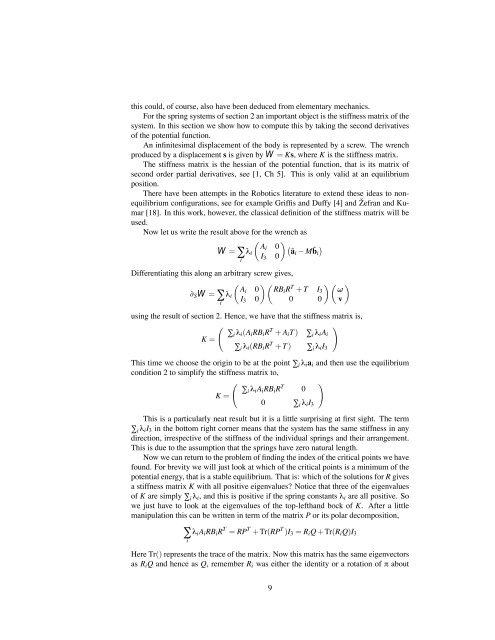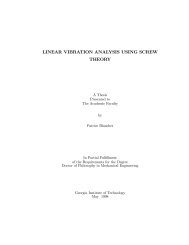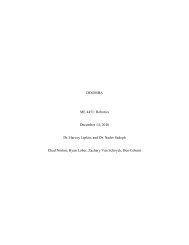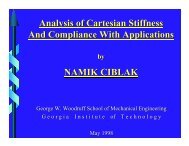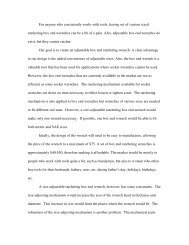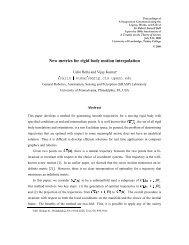this could, of course, also have been deduced from elementary mechanics.For the spr<strong>in</strong>g systems of section 2 an important object is the stiffness matrix of thesystem. In this section we show how to compute this by tak<strong>in</strong>g the second derivativesof the potential function.An <strong>in</strong>f<strong>in</strong>itesimal displacement of the body is represented by a screw. The wrenchproduced by a displacement s is given by W = Ks, where K is the stiffness matrix.The stiffness matrix is the hessian of the potential function, that is its matrix ofsecond order partial derivatives, see [1, Ch 5]. This is only valid at an equilibriumposition.There have been attempts <strong>in</strong> the <strong>Robotics</strong> literature to extend these ideas to nonequilibriumconfigurations, see for example Griffis and Duffy [4] and Žefran and Kumar[18]. In this work, however, the classical def<strong>in</strong>ition of the stiffness matrix will beused.Now let us write the result above for the wrench as( )Ai 0 )W = ∑λ iIi 3 0(ãi − M ˜b iDifferentiat<strong>in</strong>g this along an arbitrary screw gives,( )(Ai 0 RBi R∂ S W = ∑λ T )+ T I 3 ωiIi 3 0 0 0)(vus<strong>in</strong>g the result of section 2. Hence, we have that the stiffness matrix is,( )∑i λ i (A i RB i R T + A i T ) ∑ i λ i A iK =∑ i λ i (RB i R T + T ) ∑ i λ i I 3This time we choose the orig<strong>in</strong> to be at the po<strong>in</strong>t ∑ i λ i a i and then use the equilibriumcondition 2 to simplify the stiffness matrix to,( )∑i λ i A i RB i R T 0K =0 ∑ i λ i I 3This is a particularly neat result but it is a little surpris<strong>in</strong>g at first sight. The term∑ i λ i I 3 <strong>in</strong> the bottom right corner means that the system has the same stiffness <strong>in</strong> anydirection, irrespective of the stiffness of the <strong>in</strong>dividual spr<strong>in</strong>gs and their arrangement.This is due to the assumption that the spr<strong>in</strong>gs have zero natural length.Now we can return to the problem of f<strong>in</strong>d<strong>in</strong>g the <strong>in</strong>dex of the critical po<strong>in</strong>ts we havefound. For brevity we will just look at which of the critical po<strong>in</strong>ts is a m<strong>in</strong>imum of thepotential energy, that is a stable equilibrium. That is: which of the solutions for R givesa stiffness matrix K with all positive eigenvalues? Notice that three of the eigenvaluesof K are simply ∑ i λ i , and this is positive if the spr<strong>in</strong>g constants λ i are all positive. Sowe just have to look at the eigenvalues of the top-lefthand bock of K. After a littlemanipulation this can be written <strong>in</strong> term of the matrix P or its polar decomposition,∑λ i A i RB i R T = RP T + Tr(RP T )I 3 = R i Q + Tr(R i Q)I 3iHere Tr() represents the trace of the matrix. Now this matrix has the same eigenvectorsas R i Q and hence as Q, remember R i was either the identity or a rotation of π about9
an eigenvector of Q. So let us assume that the eigenvalues of Q are µ 1 , µ 2 and µ 3with correspond<strong>in</strong>g eigenvectors e 1 , e 2 and e 3 . Assum<strong>in</strong>g that R i is a rotation abouteigenvector e i , we can f<strong>in</strong>d the eigenvalues of the matrices by consider<strong>in</strong>g the action onthe eigenvectors e 1 , e 2 and e 3 . The eigenvalues for R 0 Q + Tr(R 0 Q)I 3 are,(2µ 1 + µ 2 + µ 3 ), (µ 1 + 2µ 2 + µ 3 ), and (µ 1 + µ 2 + 2µ 3 )We only need to look at one other matrix s<strong>in</strong>ce the other are just cyclic permutations,the eigenvalues of R 1 Q + Tr(R 1 Q)I 3 are,(2µ 1 − µ 2 − µ 3 ), (µ 1 − 2µ 2 − µ 3 ), and (µ 1 − µ 2 − 2µ 3 )Now there are just two cases to consider, if det(P) > 0 then we can assume that Qis positive-def<strong>in</strong>ite and thus so are all its eigenvalues. In this case it is easy to see thatthe critical po<strong>in</strong>t represented by R 0 will be the m<strong>in</strong>imum. This is the solution R = R p .In the other case det(P) < 0, the classical polar decomposition gives us a positivedef<strong>in</strong>itesymmetric matrix and a reflection. When we multiply these by −1 wegetarotation and a negative-def<strong>in</strong>ite symmetric matrix. That is Q has all negative eigenvalues.If we assume that these eigenvalues have the order<strong>in</strong>g 0 > µ 1 ≥ µ 2 ≥ µ 3 , that is µ 1is the eigenvalue of smallest magnitude, then the matrix, R 1 Q + Tr(R 1 Q)I 3 will haveall positive eigenvalues and hence R 1 corresponds to the m<strong>in</strong>imum of the potential. So<strong>in</strong> general, if det(P) < 0 the m<strong>in</strong>imum solution is given by R = R p R i , where R i is arotation of π about the eigenvector of Q with eigenvalue of smallest magnitude.6 ConclusionsThe concept unify<strong>in</strong>g the three problems we have studied <strong>in</strong> this work is the idea offunctions def<strong>in</strong>ed on the group of rigid body transformations. We have been able to f<strong>in</strong>dthe stationary po<strong>in</strong>ts of the functions and classify these critical po<strong>in</strong>ts. This <strong>in</strong>volves asimple technique of differentiat<strong>in</strong>g along a screw.The results agree with those of Kanatani [7, Chap. 5], his methods were, perhaps,a little more elegant than the above. But the methods used here are more general, wehave found all the critical po<strong>in</strong>ts of the potential function not just the m<strong>in</strong>imum andwith a little more effort we could f<strong>in</strong>d the <strong>in</strong>dex of each of them.These ideas are central to the subject of Morse theory, a field of study which relatesthe critical po<strong>in</strong>ts of functions def<strong>in</strong>ed on a manifold to the topology of the manifolditself. In this case the topology of the manifold, the underly<strong>in</strong>g manifold of the groupSO(3), is well known, and we can use this to say someth<strong>in</strong>g about the critical po<strong>in</strong>t ofour potential function.The problem of the spr<strong>in</strong>gs is a slightly artificial one <strong>in</strong> that we have used spr<strong>in</strong>gswill zero natural length. This simplifies the computations. It is possible to repeat mostof the above analysis us<strong>in</strong>g spr<strong>in</strong>g with a f<strong>in</strong>ite natural length, see [14]. The numberof critical po<strong>in</strong>ts now becomes a very hard problem but will still be constra<strong>in</strong>ed by thetopology of the group.The problem of estimat<strong>in</strong>g a rigid motion from po<strong>in</strong>t data is reasonably realistic.The utility of the estimate will depend on the distribution of error for the measuredpo<strong>in</strong>ts. There are some results on this <strong>in</strong> the literature, see [17]. However, I believethere is much scope for further research <strong>in</strong> this direction.10


